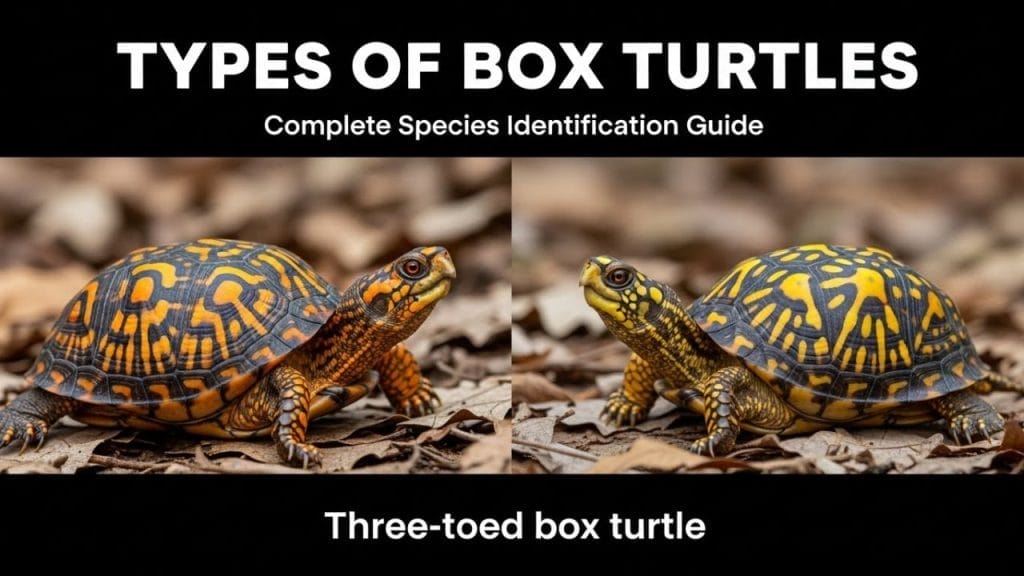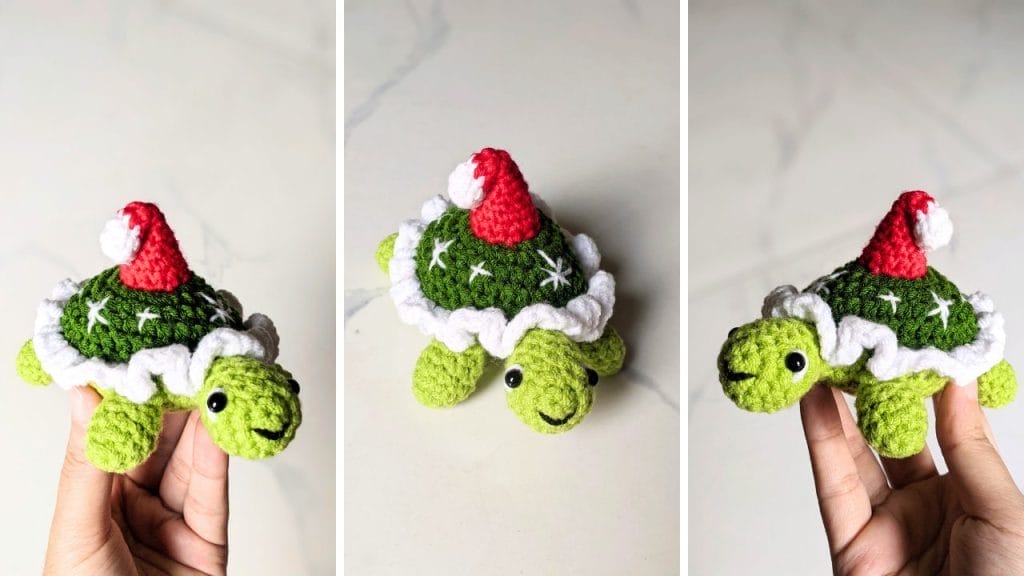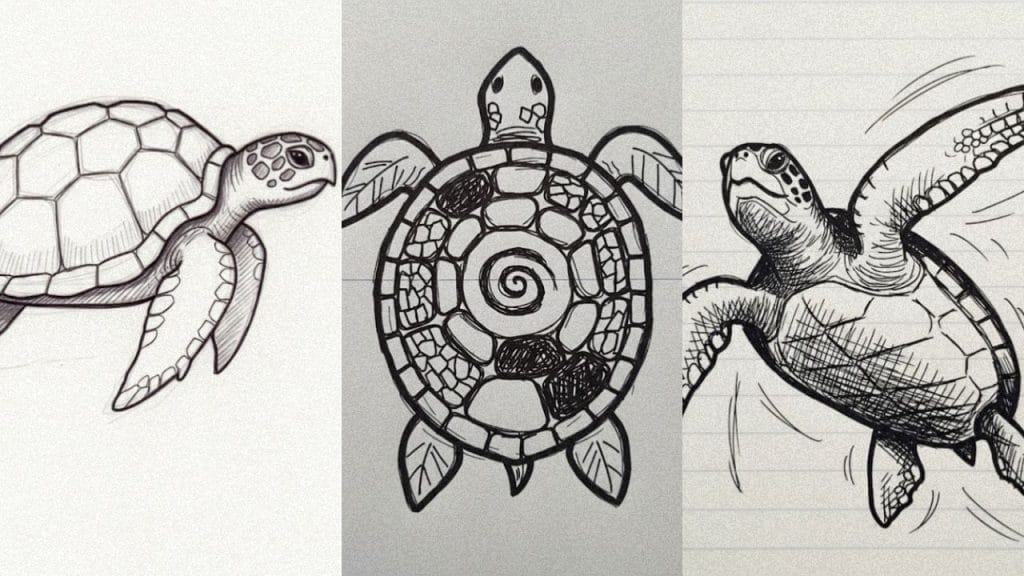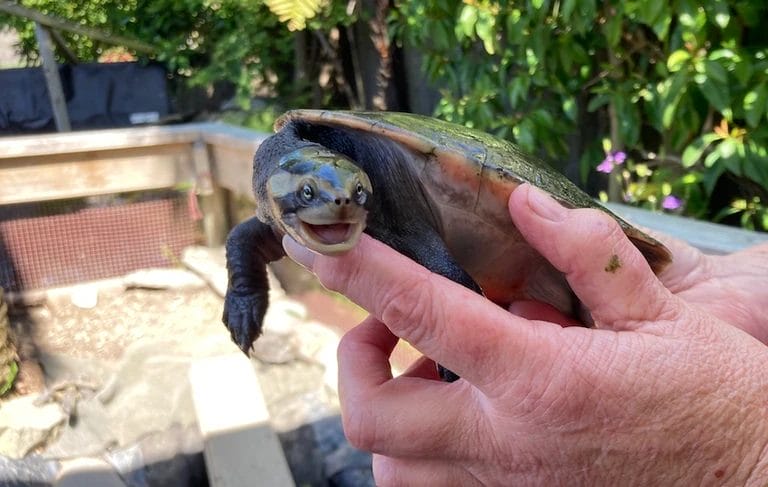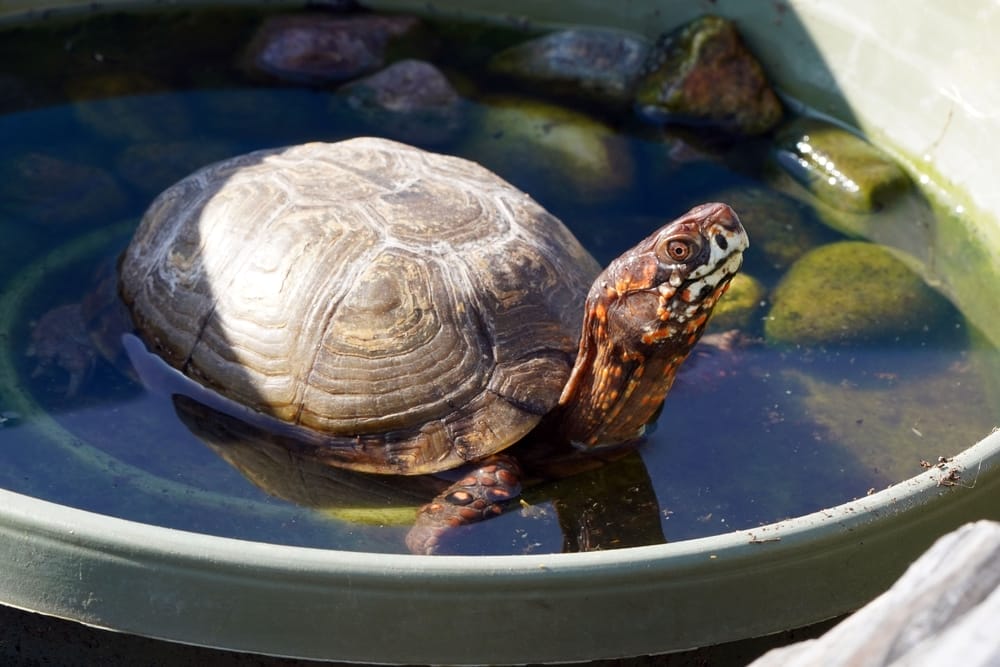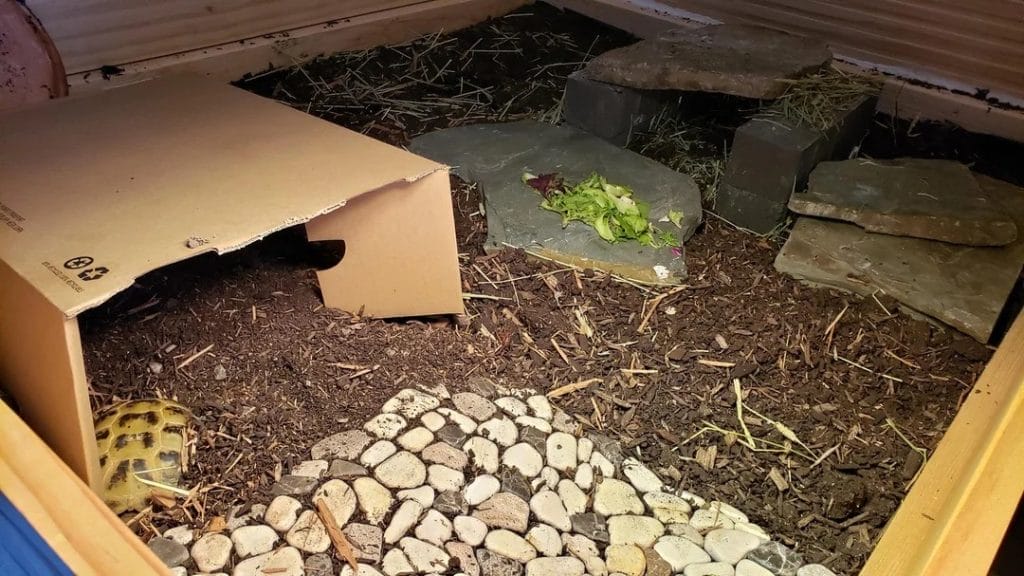Creating a Turtle Pond? Here’s What It Really Costs (and How to Save Big)

This post was created with help from AI tools and carefully reviewed by a human (Muntaseer Rahman). For more on how we use AI on this site, check out our Editorial Policy.
Building a turtle pond sounds like an expensive dream, but it doesn’t have to be!
Many new turtle pond enthusiasts are surprised by just how affordable it can be with a little planning.
From selecting budget-friendly materials to DIYing the essentials, here’s a complete breakdown of what it really costs and exactly how to save along the way.
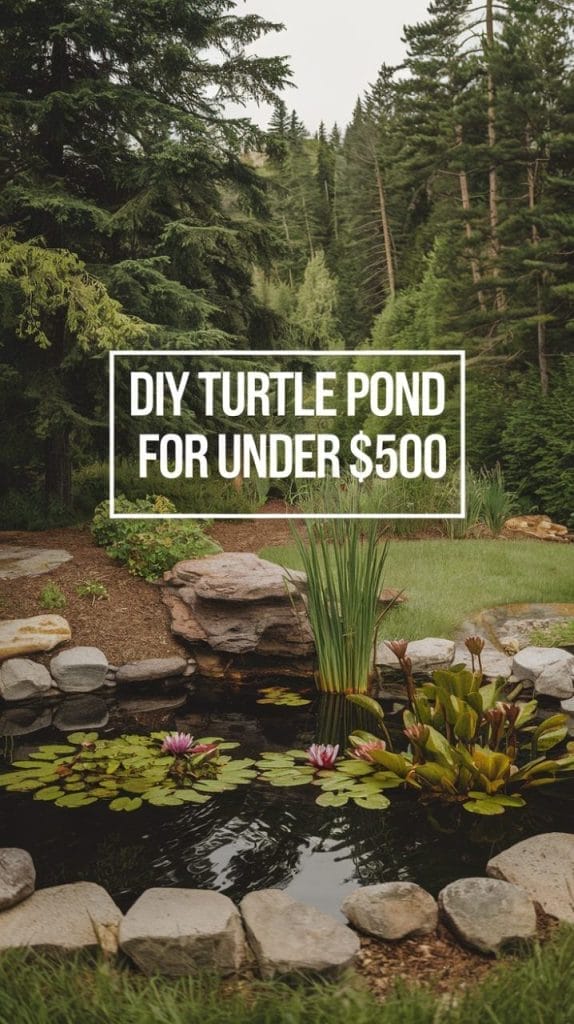
Estimating Your Total Initial and Monthly Costs
Building a turtle pond can be as simple or fancy as you want. But whether you go budget-friendly or luxury, it’s smart to have a ballpark figure in mind.
Let’s break down what you can expect to pay upfront and month-to-month.
Total Initial Setup Costs: $500–$3,000+
Here’s a look at the main costs you might face in creating a basic turtle pond:
| Item | Cost Range | Notes on Saving |
|---|---|---|
| Liner | $50–$300 | DIY installation or local supplier deals |
| Pumps & Filters | $100–$500 | Combined kits are cheaper |
| Heater | $50–$200 | Energy-efficient or solar if possible |
| Plants & Decor | $50–$150 | Use native plants or local stones |
| Fencing | $100–$500 | Repurpose materials like chicken wire |
Total Upfront Estimate: $500 to $3,000 depending on size and choices.
When I built my own pond, I aimed for the low end of each range. I hunted for sales, bought bulk, and repurposed materials whenever I could. My final cost was just under $600!
Want a budget-friendly alternative? Our kiddie pool turtle pond setup costs under $100 and works great for small turtles.
Indoor setups offer different cost considerations—see how to make an indoor turtle pond for climate-controlled alternatives that eliminate seasonal equipment costs.

Ongoing Monthly Costs: $20–$50
Turtle ponds aren’t high-maintenance, but there are a few regular expenses to keep things running smoothly.
- Water Treatment: Expect to spend $5–$10 per month for dechlorinators or water conditioners. Some people swear by using natural conditioners, like adding more plants, to cut costs.
- Electricity: Running a pump, heater, and lighting can add about $10–$30 to your monthly utility bill. Energy-efficient pumps save a lot here.
- Food & Supplements: Turtles eat a mix of pellets, plants, and insects, costing around $5–$15 monthly. Buying bulk pellets saves me money, and my turtles love the variety!
Total Monthly Estimate: $20 to $50, depending on climate, pond size, and the turtles’ diet.
Planning your budget means fewer surprises later. Investing in quality equipment can keep maintenance costs down, and every dollar saved upfront gives you more to spend on fun add-ons later—like a mini waterfall!
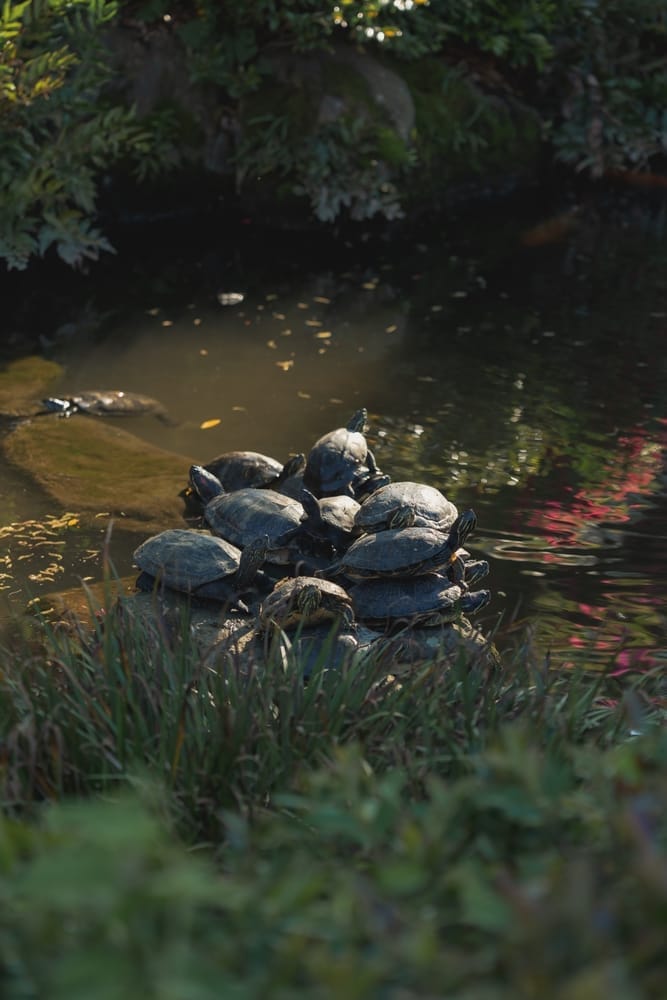
Design Costs: Planning Your Pond
Creating a turtle pond sounds easy until you get to the design stage. This is where reality kicks in, and costs can creep up quickly. Here’s what to expect (and some ways to save).
Professional Design vs. DIY
| Option | Average Cost | Pros | Cons |
|---|---|---|---|
| Professional | $200–$1,000+ | Custom plan, expert recommendations | Can be pricey |
| DIY | $0–$50 (for materials) | Cost-effective, creative freedom | Requires time, research, and patience |
Going Pro? Here’s What to Expect
Hiring a pond designer can make everything feel seamless. They’ll figure out the right layout, the best depth, and the ideal materials.
But here’s the kicker: this expertise often costs between $200 and $1,000. The bigger and more complex the pond, the higher the bill. If you’re planning a small, simple setup, a designer might not be worth the splurge.
However, if you want a multi-level pond with waterfalls, professional help might save you from mistakes.
Saving Tip: If you’re leaning towards a complex pond, look for designers who offer “consultation-only” packages. They’ll map out a design for less than a full-service project.

DIY Design – Yes, You Can!
Want to save? Go the DIY route! With a bit of research (YouTube is your friend here), you can design a pond that works well and fits your space.
DIY can be free or low-cost, especially if you’re sketching your ideas or printing templates.
My Experience: I chose the DIY path, armed with graph paper and colored pencils. It wasn’t perfect, but seeing my plan come to life was rewarding—and it cost me about $10 in stationery!
Helpful Tools for DIY Design
Here are some low-cost tools to make your DIY design easier and more accurate:
- Graph Paper: For scaling and planning ($1–$5).
- Online Tools: Free design apps like SketchUp or Roomstyler for basic layout and size planning.
- Pond Design Kits: Some online shops sell template kits, including rulers, shape cutouts, and guides ($10–$20).
Saving Tip: If you’re nervous about DIY, try a “mock-up” design outside using a garden hose to lay out the shape. This lets you adjust and visualize before digging.
Total Cost Summary for Design
- Professional Design: $200–$1,000+
- DIY Design Materials: $0–$50
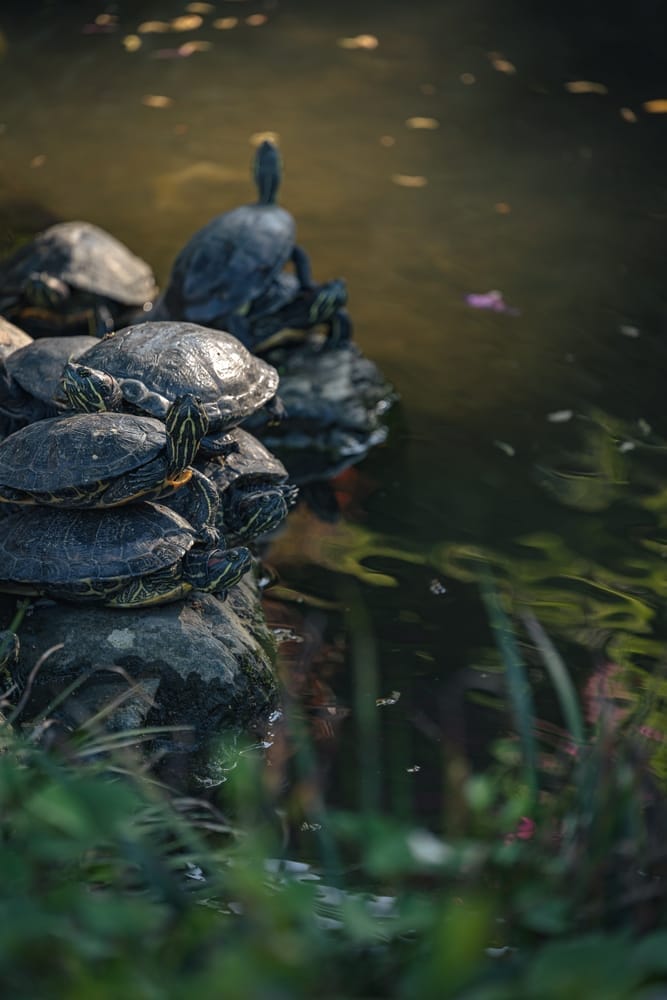
This Hilarious Turtle Book Might Know Your Pet Better Than You Do
Let’s be real—most turtle care guides feel like reading a textbook written by a sleep-deprived zookeeper.
This one’s not that.
Told from the snarky point of view of a grumpy, judgmental turtle, 21 Turtle Truths You’ll Never Read in a Care Guide is packed with sarcasm, sass, and surprisingly useful insights.
And hey—you don’t have to commit to the whole thing just yet.
Grab 2 free truths from the ebook and get a taste of what your turtle really thinks about your setup, your food choices, and that weird plastic palm tree.
It’s funny, it’s honest, and if you’ve ever owned a turtle who glares at you like you’re the problem—you’ll feel seen.
Materials Cost for Pond Construction
Now, let’s break down the costs for basic materials! A little planning goes a long way here, and I’ve learned firsthand that you don’t always need to splurge to make it great.
| Material | Average Cost | Budget Tip |
|---|---|---|
| Flexible Liner | $50 – $200 | Look for off-season sales |
| Pre-Formed Liner | $100 – $300 | DIY for small ponds |
| Concrete | $500 – $1,000 | Ask contractors for leftover mix |
| Edging Stones/Bricks | $100 – $300 | Check for free or clearance options |
1. Pond Liner
- Flexible Liners: Ideal for custom shapes. These usually range from $50 to $200 depending on size and thickness.
- Pre-Formed Liners: Easier to install but limited to specific shapes. Expect to pay between $100 and $300.
- My Tip: I went with a flexible liner because it let me get creative with shape! Also, look for sales or off-season discounts for good deals.
2. Concrete (Optional)
- Cost Range: For a permanent, long-lasting pond, concrete is a great option but pricier—typically $500–$1,000 for materials alone.
- My Tip: If you’re set on concrete, check with local contractors for leftover mix. Sometimes they’ll sell it for a discount if it’s a small job.
3. Edging Materials (Rocks, Bricks, or Pavers)
- Cost Range: Stones, bricks, or pavers help with pond structure and design, costing around $100–$300.
- DIY Tip: Grab some rocks from nature if it’s allowed in your area! Or check for landscaping sales—you’d be surprised what you can find on clearance.
The key to saving here? Get creative with your materials. Ask around and stay flexible—you’d be surprised how much you can save with a bit of resourcefulness!
Ready to start building? Follow our ultimate outdoor turtle pond setup guide for step-by-step instructions using these materials.
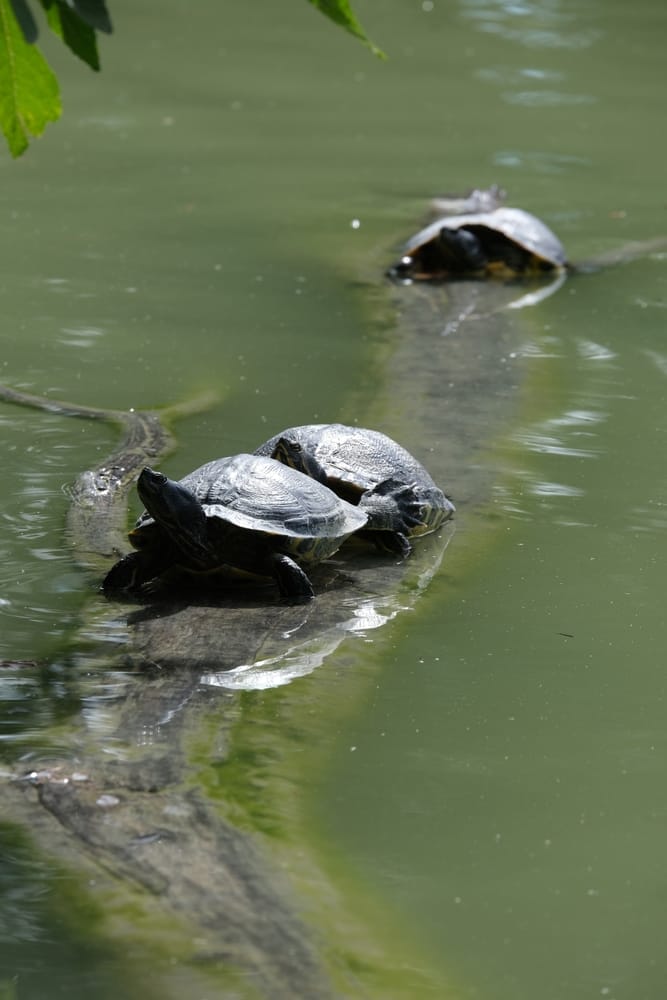
Filtration and Water Pump Costs
Keeping your pond clean is essential for happy, healthy turtles—and for keeping that water fresh! Here’s what you need to know about filtration and pump costs, with some clever ways to save a few bucks.
1. Types of Filtration Systems
There are two main types of filters for turtle ponds, each with its own cost and benefits:
| Type | Cost Range | Description |
|---|---|---|
| Basic Filters | $50–$200 | Good for smaller ponds, handles basic debris and waste |
| Biological Filters | $150–$500 | Ideal for larger ponds, manages both waste and water quality |
- Basic Filters: These work well for small, simple ponds. They’re affordable and easy to set up.
- Biological Filters: If you’re serious about water quality or have a bigger pond, biological filters are worth the splurge.
Saving Tip: Look for combo kits that include both a filter and pump—often cheaper than buying each separately.
2. Water Pump Options
Your pump size depends on your pond’s volume. Small ponds don’t need a powerhouse, but larger ponds do.
| Pump Size | Cost Range | Best For |
|---|---|---|
| Small Pump | $50–$100 | Ponds under 500 gallons |
| Medium Pump | $100–$200 | Ponds up to 1,000 gallons |
| Large Pump | $200–$300 | Ponds over 1,000 gallons |
- Small Pumps: Perfect if you’re keeping things cozy with a smaller setup.
- Medium to Large Pumps: For a bigger pond, these pumps keep water circulating to prevent algae build-up.
Saving Tip: Invest in an energy-efficient pump—less electricity, and it saves money in the long run.
3. Total Cost Estimate (Pump + Filter)
Depending on your pond’s size and needs, here’s a rough cost estimate:
| Pond Size | Filter + Pump Combo Cost |
|---|---|
| Small Pond | $100–$300 |
| Medium Pond | $200–$500 |
| Large Pond | $300–$800 |
4. Personal Tip
When I set up my first pond, I thought a simple filter would do. Wrong! I ended up having to upgrade because my pond was murkier than a swamp in no time. Learned my lesson—get the filter that matches your pond size.
Extra Tip: Shop during seasonal sales (spring and early fall) when pond supplies are often discounted.
Investing in a good pump and filter combo keeps your pond clear, your turtles happy, and your cleaning time minimal. Worth every penny, trust me!

Heating and Lighting Cost for Turtle Health
Creating the right environment for turtles isn’t just about keeping them cozy; it’s essential for their health and happiness!
Here’s a breakdown of what you’ll spend on heating and lighting (plus a few ways to cut those costs).
Heating Costs: Keeping the Water Comfortable
Turtles are cold-blooded, so if it gets too chilly, they can’t regulate their body temperature. In colder climates, a water heater is a must.
Basic Pond Heater
- Cost: $50–$200
- Simple heaters are great for small ponds or mild climates. They do the job without fancy extras.
Submersible Heaters
- Cost: $100–$300
- These go directly in the water and are more powerful. They’re ideal for bigger ponds or regions with cooler temperatures.
Solar Heaters
- Cost: $50–$150 (one-time investment)
- Solar-powered options can save big on energy, but they rely on good sunlight. Perfect for warm, sunny areas.
Pro Tip: My friend used an aquarium heater for her tiny pond – not perfect, but it kept her turtle happy for under $50!
Lighting Costs: Keeping Turtles Healthy
Turtles need light to stay healthy, especially UVB light. It helps them absorb calcium and keeps their shells strong. So, lighting isn’t just for looks; it’s crucial.
UVB Bulbs
- Cost: $20–$60 (lasts about 6 months)
- UVB is a non-negotiable for turtle health. The bulb helps prevent shell deformities and other health issues. Most need replacing twice a year.
Energy-Saving LED Lights
- Cost: $10–$30
- Great for general lighting. These add light to the pond without burning through electricity. They work well in areas where UVB is not as critical or in combination with it.
Quick Hack: If you’re in a sunny area, natural sunlight can be your UVB source! Just make sure your pond gets some direct sun daily.
Total Cost Overview: Heating and Lighting
| Item | Cost Range | Frequency |
|---|---|---|
| Basic Pond Heater | $50–$200 | One-time |
| Submersible Heater | $100–$300 | One-time |
| Solar Heater | $50–$150 | One-time |
| UVB Bulb | $20–$60 | Every 6 months |
| LED Light | $10–$30 | One-time |
Saving Tips
- Combine Solar & Electric: Use a basic heater but add solar panels for extra warmth.
- Maximize Natural Light: Place your pond in a sunny spot, and you’ll save on UVB bulbs.
Heating and lighting aren’t the cheapest parts of a turtle pond setup, but skimping here will lead to more costly vet bills.
Plus, a warm, well-lit turtle is a happy turtle!
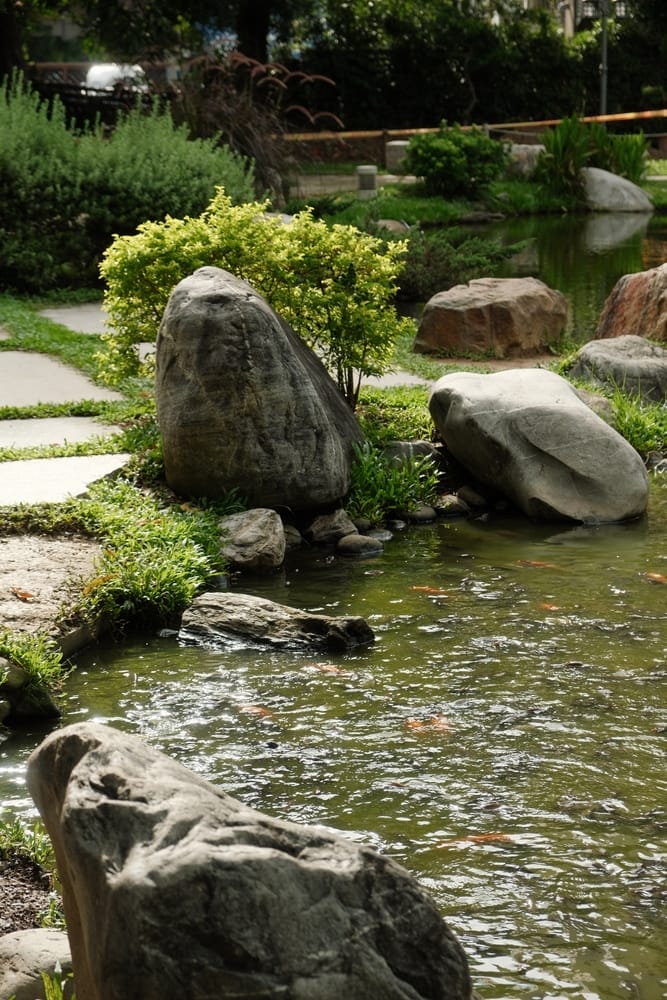
Plants and Habitat Additions Cost
Adding plants and hiding spots isn’t just for looks. Turtles need a mix of greenery and cozy spots to stay healthy, feel secure, and enjoy their new home! Here’s what you might spend and where to save a few bucks.
Aquatic Plants
These plants keep water clean, provide shade, and make turtles feel at home. Here’s a breakdown:
| Plant Type | Average Cost |
|---|---|
| Water Lilies | $10–$30 each |
| Duckweed | $5–$10 per bag |
| Water Lettuce | $5–$15 each |
| Hornwort | $5–$20 per bunch |
- Pro Tip: You only need a few plants to get started! Many spread quickly, so they can fill in your pond naturally over time.
- My Story: I started with just one bag of duckweed, and it multiplied so fast that I started giving some away!
Rocks, Logs, and Hiding Spots
Turtles love places to bask, hide, and explore. These items not only help turtles feel safe but also give the pond a natural look.
- Rocks and Stones: $20–$100 depending on size and quantity
- Driftwood or Logs: Around $10–$50 (or free if you find them in nature!)
- Turtle Caves or Hides: $10–$30
- Money Saver: Check your local area for free rocks or driftwood. Just make sure they’re clean and safe for a pond.
- Pro Tip: Add these gradually. Turtles love rearranging things, so starting small lets you see what they like best.
Budgeting Summary
Here’s what you’re looking at for these habitat essentials:
| Item | Cost Range |
|---|---|
| Aquatic Plants | $20–$100 |
| Rocks and Stones | $20–$100 |
| Logs and Hides | $10–$50 |
Total: $50–$250
With some creativity and patience, you can keep costs low while creating a perfect turtle paradise. Plus, searching for the perfect log or rock can turn into a fun adventure (just maybe bring gloves!).

Cost for Turtle-Friendly Fencing and Security
Turtles love exploring, which means they’re also escape artists! Fencing keeps them in and predators out.
Here’s what you’re looking at cost-wise, plus a few ways to save without sacrificing security.
| Security Feature | Cost Range | Description | Money-Saving Tips |
|---|---|---|---|
| Pre-Made Fencing Kits | $100–$300 | Easy-to-assemble kits sized for smaller ponds. | Shop sales or look for clearance kits. |
| DIY Custom Fencing | $50–$200 | Use materials like chicken wire or garden stakes for DIY. | Use reclaimed wood or scrap materials. |
| Professional Installation | $300–$500 | Professional setup if you want expert installation. | Ask around for local deals or off-season rates. |
| Basic Pond Netting | $20–$50 | Lightweight netting to cover pond and deter small predators. | Repurpose old mesh netting if you have any. |
| Heavy-Duty Netting | $40–$80 | Reinforced, durable netting for areas with larger predators. | Buy only for predator-prone zones. |
1. Fence Installation Costs
- Pre-Made Fencing Kits: Around $100–$300. These kits are easy to assemble and often come in turtle-friendly sizes.
- Custom DIY Fencing: $50–$200 depending on materials. You can customize height and spacing, but you might need basic tools.
- Professional Installation: Expect $300–$500 if you prefer to leave it to the pros.
Personal Note: When I made my own turtle enclosure, I went DIY with chicken wire and garden stakes. It wasn’t fancy, but it kept the turtles safe and cost me under $100!
2. Netting and Covers for Predator Protection
- Basic Pond Netting: $20–$50 for simple nets to place over the pond. These are especially useful if you have birds or raccoons in the area.
- Heavy-Duty Netting: $40–$80 for reinforced options. These last longer and offer more protection but are still budget-friendly.
Tip: I got creative with some old mesh netting I had in the garage. A quick cover over the pond saved me a few bucks and worked like a charm!
3. Saving Tips for Turtle Fencing and Security
- Use Recycled Materials: Reclaimed wood, leftover mesh, or even a garden trellis can work as a makeshift fence.
- Consider Chicken Wire: It’s cheap, easy to install, and keeps turtles in (though it may not keep larger predators out).
- Shop Local Sales: Check for sales on outdoor fencing materials at hardware stores, especially in the off-season.
Building turtle security doesn’t have to break the bank. With a few creative choices, you can keep your shelled friends safe without splurging.

Water Quality Maintenance Costs
Keeping a turtle pond clean is key to happy, healthy turtles—but it’s not free. Here’s what to expect and a few clever ways to cut costs without skimping on quality.
Testing Kits
Good water quality means checking pH, ammonia, and other levels. Testing kits are a small but important expense.
| Item | Average Cost | Frequency |
|---|---|---|
| Testing Kit | $10–$30 | Every 3–6 months |
Cost-Saving Tip: Instead of fancy kits, you can use strips, which are cheaper. But make sure they’re reliable!
Water Treatment
You’ll need to treat tap water to make it turtle-friendly. Conditioners remove chlorine and heavy metals, protecting turtles from toxins.
| Item | Average Cost | Frequency |
|---|---|---|
| Water Conditioner | $5–$20 | Monthly |
| Dechlorinator Tabs | $10–$30 (bulk) | Every 2–3 months |
Cost-Saving Tip: Get bulk bottles or packs of water conditioner. They’re cheaper over time and last for months.
Natural Options: Plants
Aquatic plants are a hidden gem. They help keep water clean by reducing waste and providing natural filtration.
| Item | Average Cost | Lifespan |
|---|---|---|
| Aquatic Plants | $20–$100 | Months to years |
Cost-Saving Tip: Start with just a few hardy plants like duckweed or water hyacinth. They grow fast and can even be free if you know a pond owner!
My “Oops, Forgot the Conditioner” Story: Once, I forgot to use water conditioner after a water change. My turtle, Oliver, spent the next day sulking on his rock, and I got a crash course in why quality matters.
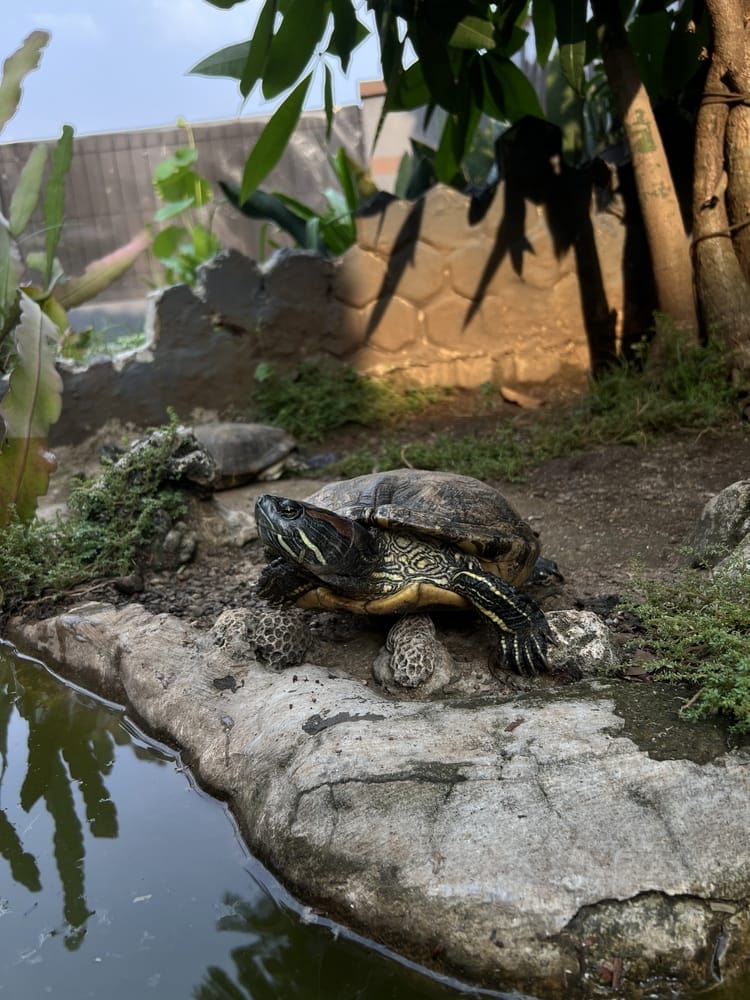
Initial and Ongoing Turtle Care Costs
Creating a turtle pond isn’t just a one-time expense. Turtles have ongoing needs, and while these costs aren’t huge, they can add up if you’re not prepared. Here’s what to expect for both the initial setup and regular care.
Turtle Food and Supplements
Turtles need a varied diet. Most of their food costs will be ongoing:
- Pellets: These are the main part of their diet, costing about $5–$20 per month depending on your turtle’s size and appetite.
- Fresh Veggies and Fruits: Adding greens like lettuce or occasional treats like apples can cost another $5–$10 each month.
- Calcium Blocks and Vitamins: These support shell health and growth, costing around $3–$10 monthly.
Buying turtle pellets in bulk can save quite a bit and keeps you stocked up. I learned this the hard way after way too many last-minute pet store runs.
Health and Wellness Supplies
Turtles need a clean, balanced environment, which requires some maintenance supplies:
- Water Conditioners: Essential for keeping water safe and healthy, usually costing $5–$15 per month.
- Thermometers: To monitor both water and basking temperatures. These are a one-time purchase, about $10–$15.
- Medicines or Vet Visits: Turtles can get sick too. A single vet visit can range from $50–$150 depending on the issue, so it’s smart to budget a little for emergencies.
I skipped buying a thermometer at first, thinking I could just “tell” the temperature. That backfired quickly when my turtles seemed sluggish from the cold. Lesson learned.
Enrichment and Replacement Supplies
Adding variety to your turtle’s environment is important, and a few simple items make a big difference:
- New Hides and Logs: Turtles love hiding and climbing, so occasional new pieces cost around $10–$30.
- Plant Replacements: If you use live plants, they may need replacing every few months, costing $10–$20 each time.
I found that swapping out rocks or plants from time to time kept my turtles curious and active without spending much.
Monthly and Annual Cost Estimate Table
| Item | Monthly Cost | Annual Cost |
|---|---|---|
| Turtle Food & Veggies | $10–$20 | $120–$240 |
| Supplements | $3–$10 | $36–$120 |
| Water Conditioners | $5–$15 | $60–$180 |
| Health Supplies | $0–$15* | $50–$150 |
| Enrichment & Replacements | $5–$15 | $60–$180 |
*Varies based on health needs or emergencies.
Final Thoughts on Turtle Care Costs
For ongoing care, expect monthly costs to hover around $20–$50, with a little extra set aside for emergencies or occasional upgrades.
It’s easy to overlook these smaller expenses at first, but planning ahead ensures that both you and your turtles have a smooth, low-stress experience.
Remember to budget for winter preparation—our turtle pond winterization guide lists essential cold-weather equipment and seasonal costs.
Outdoor turtle pond setup guide infographic
For a printable version of this infographic, click here!

About Author
Muntaseer Rahman started keeping pet turtles back in 2013. He also owns the largest Turtle & Tortoise Facebook community in Bangladesh. These days he is mostly active on Facebook.



